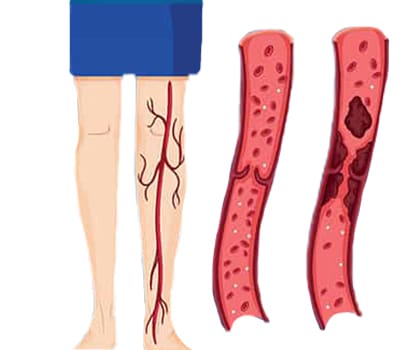Deep Vein Thrombosis Treatment by Best Vascular Surgeons
Vascular Interventions provides the best Treatments for Blood Clots in Leg. Deep Vein Thrombosis is a common disorder, which is related to the formation of blood clots in major veins. It will affect any age group however the risk of developing a DVT increase after the age of 40 years. DVT has been linked in recent years with long-distance air travel.
This can be life-threatening, especially when the embolism occurs in the lungs, heart, or brain. Pulmonary embolism (a blood clot in the lung) is the most general of these severe DVT complications. DVT Thrombolysis Procedure is used for the Treatments for Blood Clots in Leg.

- Discoloration of the legs
- Calf or leg pain or tenderness
- Swelling of the leg or lower limb
- Warm skin
- Surface veins become more visible
- Leg fatigue
If you’ve deep vein thrombosis (DVT), you’ll need to take a medicine called an anticoagulant. Anticoagulant medicines prevent blood clots from getting bigger. They can additionally facilitate a part of the blood clot breaking off and becoming lodged in another part of your bloodstream (an embolism). Although they’re typically mentioned as “blood-thinning” medicines, anticoagulants don’t thin the blood. They alter proteins inside it, which prevents clots from forming so easily.
Heparin and Warfarin are 2 types of anticoagulants that are usually used to treat DVT. Heparin is usually prescribed first because it works right away preventing any further clotting. After this initial treatment, you may also need to take warfarin to avoid another blood clot to form.
The body naturally absorbs a blood clot over the course of time, it may take many weeks to months, and the symptoms which accompanied the blood clot gradually improve and ultimately disappear. Most patients with DVT or PE recuperate within several weeks to months without significant complications or long-term effects.
Q: Can DVT go away
A: Even a surface clot, which is a very minor issue, can take weeks to go away. If you have a DVT or pulmonary embolism, you typically get more and more relief as the clot gets smaller. The pain and swelling from a DVT generally start to get better within days of treatment. A blood clot puts severe stress on your body.
